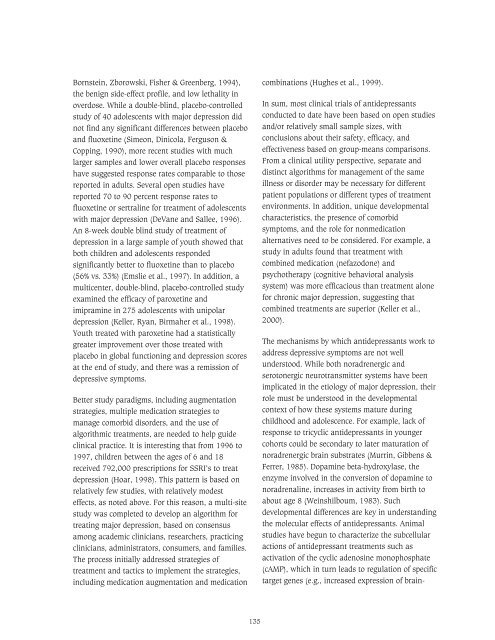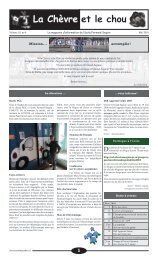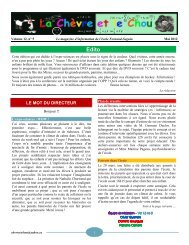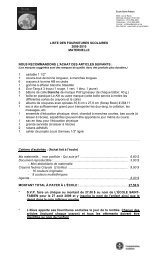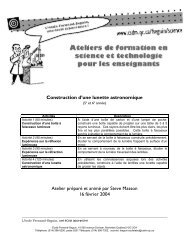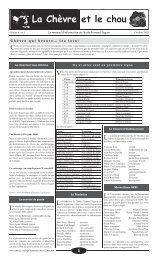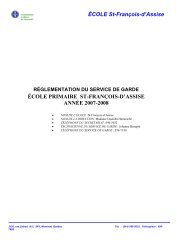Research on Child and Adolescent Mental Health
Research on Child and Adolescent Mental Health
Research on Child and Adolescent Mental Health
Create successful ePaper yourself
Turn your PDF publications into a flip-book with our unique Google optimized e-Paper software.
Bornstein, Zborowski, Fisher & Greenberg, 1994),<br />
the benign side-effect profile, <strong>and</strong> low lethality in<br />
overdose. While a double-blind, placebo-c<strong>on</strong>trolled<br />
study of 40 adolescents with major depressi<strong>on</strong> did<br />
not find any significant differences between placebo<br />
<strong>and</strong> fluoxetine (Sime<strong>on</strong>, Dinicola, Fergus<strong>on</strong> &<br />
Copping, 1990), more recent studies with much<br />
larger samples <strong>and</strong> lower overall placebo resp<strong>on</strong>ses<br />
have suggested resp<strong>on</strong>se rates comparable to those<br />
reported in adults. Several open studies have<br />
reported 70 to 90 percent resp<strong>on</strong>se rates to<br />
fluoxetine or sertraline for treatment of adolescents<br />
with major depressi<strong>on</strong> (DeVane <strong>and</strong> Sallee, 1996).<br />
An 8-week double blind study of treatment of<br />
depressi<strong>on</strong> in a large sample of youth showed that<br />
both children <strong>and</strong> adolescents resp<strong>on</strong>ded<br />
significantly better to fluoxetine than to placebo<br />
(56% vs. 33%) (Emslie et al., 1997). In additi<strong>on</strong>, a<br />
multicenter, double-blind, placebo-c<strong>on</strong>trolled study<br />
examined the efficacy of paroxetine <strong>and</strong><br />
imipramine in 275 adolescents with unipolar<br />
depressi<strong>on</strong> (Keller, Ryan, Birmaher et al., 1998).<br />
Youth treated with paroxetine had a statistically<br />
greater improvement over those treated with<br />
placebo in global functi<strong>on</strong>ing <strong>and</strong> depressi<strong>on</strong> scores<br />
at the end of study, <strong>and</strong> there was a remissi<strong>on</strong> of<br />
depressive symptoms.<br />
Better study paradigms, including augmentati<strong>on</strong><br />
strategies, multiple medicati<strong>on</strong> strategies to<br />
manage comorbid disorders, <strong>and</strong> the use of<br />
algorithmic treatments, are needed to help guide<br />
clinical practice. It is interesting that from 1996 to<br />
1997, children between the ages of 6 <strong>and</strong> 18<br />
received 792,000 prescripti<strong>on</strong>s for SSRI’s to treat<br />
depressi<strong>on</strong> (Hoar, 1998). This pattern is based <strong>on</strong><br />
relatively few studies, with relatively modest<br />
effects, as noted above. For this reas<strong>on</strong>, a multi-site<br />
study was completed to develop an algorithm for<br />
treating major depressi<strong>on</strong>, based <strong>on</strong> c<strong>on</strong>sensus<br />
am<strong>on</strong>g academic clinicians, researchers, practicing<br />
clinicians, administrators, c<strong>on</strong>sumers, <strong>and</strong> families.<br />
The process initially addressed strategies of<br />
treatment <strong>and</strong> tactics to implement the strategies,<br />
including medicati<strong>on</strong> augmentati<strong>on</strong> <strong>and</strong> medicati<strong>on</strong><br />
combinati<strong>on</strong>s (Hughes et al., 1999).<br />
In sum, most clinical trials of antidepressants<br />
c<strong>on</strong>ducted to date have been based <strong>on</strong> open studies<br />
<strong>and</strong>/or relatively small sample sizes, with<br />
c<strong>on</strong>clusi<strong>on</strong>s about their safety, efficacy, <strong>and</strong><br />
effectiveness based <strong>on</strong> group-means comparis<strong>on</strong>s.<br />
From a clinical utility perspective, separate <strong>and</strong><br />
distinct algorithms for management of the same<br />
illness or disorder may be necessary for different<br />
patient populati<strong>on</strong>s or different types of treatment<br />
envir<strong>on</strong>ments. In additi<strong>on</strong>, unique developmental<br />
characteristics, the presence of comorbid<br />
symptoms, <strong>and</strong> the role for n<strong>on</strong>medicati<strong>on</strong><br />
alternatives need to be c<strong>on</strong>sidered. For example, a<br />
study in adults found that treatment with<br />
combined medicati<strong>on</strong> (nefazod<strong>on</strong>e) <strong>and</strong><br />
psychotherapy (cognitive behavioral analysis<br />
system) was more efficacious than treatment al<strong>on</strong>e<br />
for chr<strong>on</strong>ic major depressi<strong>on</strong>, suggesting that<br />
combined treatments are superior (Keller et al.,<br />
2000).<br />
The mechanisms by which antidepressants work to<br />
address depressive symptoms are not well<br />
understood. While both noradrenergic <strong>and</strong><br />
serot<strong>on</strong>ergic neurotransmitter systems have been<br />
implicated in the etiology of major depressi<strong>on</strong>, their<br />
role must be understood in the developmental<br />
c<strong>on</strong>text of how these systems mature during<br />
childhood <strong>and</strong> adolescence. For example, lack of<br />
resp<strong>on</strong>se to tricyclic antidepressants in younger<br />
cohorts could be sec<strong>on</strong>dary to later maturati<strong>on</strong> of<br />
noradrenergic brain substrates (Murrin, Gibbens &<br />
Ferrer, 1985). Dopamine beta-hydroxylase, the<br />
enzyme involved in the c<strong>on</strong>versi<strong>on</strong> of dopamine to<br />
noradrenaline, increases in activity from birth to<br />
about age 8 (Weinshilboum, 1983). Such<br />
developmental differences are key in underst<strong>and</strong>ing<br />
the molecular effects of antidepressants. Animal<br />
studies have begun to characterize the subcellular<br />
acti<strong>on</strong>s of antidepressant treatments such as<br />
activati<strong>on</strong> of the cyclic adenosine m<strong>on</strong>ophosphate<br />
(cAMP), which in turn leads to regulati<strong>on</strong> of specific<br />
target genes (e.g., increased expressi<strong>on</strong> of brain-<br />
135


